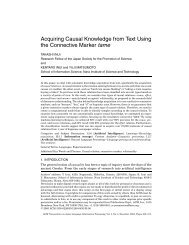ユーザの嗜好を反映したクエリ拡張を用いた情報検索・推薦システムの開発
ユーザの嗜好を反映したクエリ拡張を用いた情報検索・推薦システムの開発
ユーザの嗜好を反映したクエリ拡張を用いた情報検索・推薦システムの開発
Create successful ePaper yourself
Turn your PDF publications into a flip-book with our unique Google optimized e-Paper software.
†1 †2 googleDevelopment of Information Retrieval/Recommendation Systemusing Query Expansion based on User PreferencesJunta Mizuno , †1 Yuichi Murata and Hisashi Katsuya †2We can use web search engines such as google to retrieve necessary information effectively.However, it is needed that users construct appropriate queries. Query expansion and personalizationare help for users to do that. In this work, we proposed a query expansion methodusing latent semantic space constructed by user’s blog. By our method, an automatically personalizedquery expansion can be applied to general words. In experiments, by constructionthe products retrieval system, we congirmed the effects of our method.1 google () 1) 2) () †1 Nara Institute of Science and Technology†2 () 2008 IT !"#$%& 1: 1 p p d p ( 1 )
11/4 Amazon | Amazon.co.jp ›://www.amazon.co.jp/gp/yourstore/ref=pd_irl_gw “” “” 2: Amazon 2 3) Amazon “/” ( 2) 4) Browsing history Browser Cache Browsing activity Proxy Servers, Browser Agents,Web LogsAll user activity Desktop AgentsSearch Search Logs 5)6) tinyurl URL ⋆1 7) 3 (“”“” ) 8) 3.1 ⋆1 http://www.techcrunch.com/2009/05/07/when-it-comes-to-url-shorteners-bitly-is-now-the-biggest/( 1 ) MeCab 9) 10) ⋆2 “-” ( 2 ) “-” ( 3 ) “--- ” ( 4 ) “A B” “A” “B”“A B” “” ( 5 ) CaboCha 11) 12) “” “” “” 3.2 (3.2.1 ) p (3.2.2 ) “” “”“”“”3.2.1 ( 1 ) 1/4 a ij = i j ( 2 ) Latent Dirichlet Allocation(LDA)13) 200 ⋆3 twitter ⋆4 () 14) 3.2.2 “ p” ⋆2 http://d.hatena.ne.jp/keyword/⋆3 ⋆4 http://twitter.com
15) ⋆1 (0.735), H2(0.727), (0.684), (0.671), (0.664) (0.950), (0.944), (0.944), (0.944), (0.944) “” “” “” ⋆2 3.2.3 p p p 16) ( 1 ) “-” ( 2 ) 3.2.1 LDA “ d” p d 3.3 p d ⋆3 ⋆2 http://v.japan.cnet.com/blog/katsuya/2009/04/02/entry27021521/⋆3 http://labs.cybozu.co.jp/blog/nakatani/2007/09/web 1.html4 4.1 Yahoo 1 n (3.2.3 ) F1 3 F1 n p F1 1: F60+ nF1 + p · · · 25 + p+ dF1F430 F430 F142 4.2 “” “” ⋆4 d “” 2 2: () None A B 3 “ p d” None A B ⋆4 http://www.rakuten.co.jp/category/sake
A “” “” ⋆1 “” A “” 6 “” 1 7 ⋆2 5 p () 2008 IT 1) DavidC. Blair and M.E. Maron. An evaluationof retrieval effectiveness for a full-text documentretrievalsystem. Commun. ACM, Vol.28, No.3,pp. 289–299, 1985.2) G.Marchionini, X.Lin, and S.Dwiggins. Effectsof search and subject expertise on informationseeking in a hypertext environment. In Proceedingsof the 53rd Annual Meeting of the AmericanSociety for Information Science, Vol.27, pp. 129–142, 1990.3) PWFoltz. Using latent semantic indexing forinformation filtering. In Proceedings of the ACM⋆1 http://v.japan.cnet.com/blog/katsuya/2009/04/02/entry27021521/⋆2 SIGOIS and IEEE CS TC-OA conference on Officeinformation systems, pp. 40–47. ACM NewYork, NY, USA, 1990.4) Susan Gauch, Mirco Speretta, Aravind Chandramouli,and Alessandro Micarelli. User profilesfor personalized information access. In TheAdaptive Web, pp. 54–89. 2007.5) Georges E. Dupret and Benjamin Piwowarski.A user browsing model to predict search engineclick data from past observations. In ACM SI-GIR, pp. 331–338, 2008.6) Mamoru Komachi, Shimpei Makimoto, KeiUchiumi, and Manabu Sassano. Learning semanticcategories from clickthrough logs. In ACL-IJCNLP, pp. 189–192, 2009.7) , , , . . 2006.8) Jiafeng Guo, Gu Xu, Xueqi Cheng, and HangLi. Named entity recognition in query. In ACMSIGIR, pp. 267–274. ACM, 2009.9) , , . Conditional RandomFields . , 2004-NL-161, pp. 89–96, 2004.10) , , . Web . , 2008-SLP-71-6, pp. 39–44, 2008.11) , . . , Vol.43,No.6, pp. 1834–1842, 2002.12) , . . , 2009-NL-189-17, pp. 113–120, 2009.13) DavidM. Blei, AndrewY. Ng, and MichaelI. Jordan.Latent Dirichlet Allocation. Journal of MachineLearning Research, Vol. 3, pp. 993–1022,January 2003.14) Paul Resnick, Neophytos Iacovou, MiteshSuchak, Peter Bergstrom, and John Riedl. Grouplens:an open architecture for collaborative filteringof netnews. In CSCW ’94, pp. 175–186,1994.15) Masato Hagiwara, Yasuhiro Ogawa, and KatsuhikoToyama. PLSI Utilization for AutomaticThesaurus Construction. IJCNLP, pp. 334–345,2005.16) ChristopherD. Manning, Prabhakar Raghavan,and Hinrich Schütze. Introduction to InformationRetrieval. Cambridge University Press, 1edition, July 2008.











